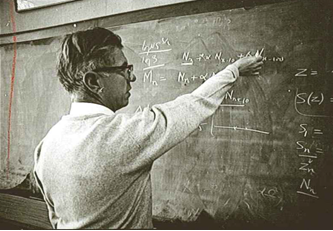- 1610: Galileo
- 1676: Ole Rømer
- 1687: Isaac Newton
- 1781: William Herschel
- 1838: Friedrich Bessel
- 1861: William and Margaret Huggins
- 1912: Henrietta Leavitt
- 1917 Einstein
- 1920: Harlow Shapley
- 1929 Edwin Hubble
- 1948: Ralph Alpher
- 1949: Fred Hoyle
- 1963: Maarten Schmidt
- 1964: Arno Penzias and Robert Wilson
- 1978: Vera Rubin and Kent Ford
- 1989: Margaret Geller and John Huchra
- 1992: John Mather and George Smoot
- 1995: Robert Williams
- 1998: Saul Perlmutter and Brian Schmidt
- 2010: Wendy Freedman
1949: Fred Hoyle and the Steady State Theory
 |
| Hoyle in and around the Institute of Theoretical Astronomy building, c. 1968. By permission of the Master and Fellows of St John's College, Cambridge. |
What may appear to be a long march from scientific ignorance to enlightenment is usually more of a slow crawl through back alleys and dead ends. The field of cosmology is an excellent case in point. Although it turned out to be wrong, the Steady State theory, proposed by Fred Hoyle, Tommy Gold, and Hermann Bodi at Cambridge University, in 1949 is worth adding to the story of cosmological discovery because it played an important role in the eventual acceptance of the Big Bang theory. In the process of developing and promoting his favored theory, Fred Hoyle answered one of the most difficult questions in cosmology—how did the heavier elements come into being?
Ralph Alpher, who is now credited for developing the mathematical underpinnings for the Big Bang theory is often pictured in front of a chalkboard. Fred Hoyle’s favorite instrument is also a chalkboard. Although telescopes have been essential tools in the advance of cosmology, the power of chalkboards, pencils, and paper should not be underestimated. After World War II cosmology joined hands with high energy particle physics, and the world of the unimaginably large came to be understood through the mathematics of the vanishingly small.